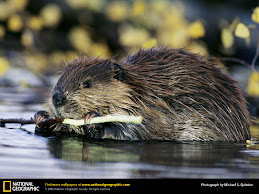Bioluminescent forests. Six-legged insectoid wolves with glistening beetle-black skin. Monstrous rhinos sporting sledgehammer horns: duck! Multi-colored pterodactyls one plugs into—and rides through the skies. Tree seeds that float through the air like jellyfish. And, of course, 10 foot tall, blue-skinned Nav’i, the movie’s central characters.
I’m not alone. Kids across the planet love the animals of Avatar; so do scientists. Science writer Carol Kaesuk Yoon, author of the recent book Naming Nature, about the importance of knowing the natural world, published a lovely piece in the New York Times agog over the glowing forests.
OK, the movie’s plot is not that deep: Dances with Wolves meets Pocahontas meets FernGully. Fine. But somehow, the damn thing worked, and fewer better environmental movies have ever been made.
And since this will soon become the highest grossing movie ever (Cameron beating his own Titanic; he’s still king of the world), the highest grossing movie will have a dark green bent and provocative activist message:
If the industrial polluters come after your sacred forests, kill them.
But there is a deep irony behind the deep ecology. As I left the movie theater, workers were collecting mountains of trash, the detritus of viewers like me, millions of trees turned into popcorn buckets to be used once and discarded. And thousands of SUVs and minivans clogged access lanes into the megaplex built on a long-gone forest that showed the film with its plea to protect forests.
For decades, since 1970’s era Silent Running with Bruce Dern, our movies—not to mention our books and TV shows—have been greener than us.
We love deep ecology entertainment, but utterly refuse to live deep ecology lives.
We mourn the loss of the Tree of Life in Avatar, but watch the Amazon disappear without a peep. In fact, we contribute to it directly through profligate waste and indirectly through inaction.
While I loved the movie, I wish I understood the irony.


3 comments:
Mike,
I was glad to find someone else who connected some deep ecology dots with Avatar (my post is at: http://sustainablesakonnet.blogspot.com/2010/01/avatar-and-deep-ecology.html)
Your comment about how people cannot take that emotion out of the movie theater and into their day-to-day is spot on. I have thought a lot about how the masses will ever change their ways. It's daunting to ponder behavior change on that grand a scale.
John Seed writes in his essay, "Beyond Anthropocentrism" (found in the book, "Thinking Like a Mountain: Towards a Council of All Beings"), that it is a change in how we view ourselves as being part of nature, not separate from it or above it, that we as a species can realize a new awareness and perspective. That turns the notion of saving the environment into saving ourselves (because we are one with the environment).
This is my first time at your blog. Great stuff. Keep up the work!
Regards,
Bill
Great post!
Tree seeds that float through the air like jellyfish. And, of course, 10 foot tall, blue-skinned Nav’i, the movie’s central characters.
Post a Comment